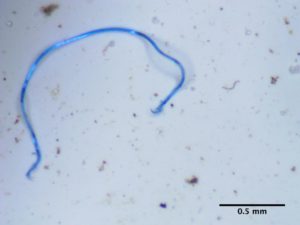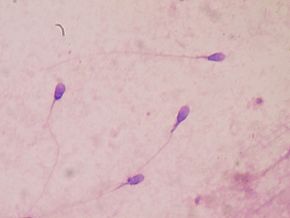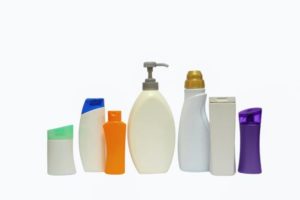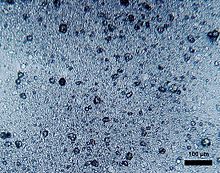
Scientists have been finding microplastics (tiny plastic particles) in our bodies - in our lungs, our blood, even our stools. The latest is a study finding microplastics in both human and dog testicles (in the testicular tissue). The small microplastics get into our bodies through inhalation and by ingestion (in the food and water), and from there they travel to different organs of the body.
They found 12 types of microplastics in all 23 human and 47 dog testicles that were studied. [NOTE: testicles = testes] In all of them! Human testicular tissue had 3 times the amount found in dogs.
They also found that higher numbers of PVC microplastics in the dog testicular tissue was correlated with a lower sperm count. (They were unable to test for this in the human samples.)

These concerning results may be part of the reason human sperm count is dropping rapidly worldwide over the past few decades. (These are thought to be contributors to the decline: pesticides, endocrine disruptors, heavy metals, plastics.) Microplastics, occur as a result of plastics breaking down, and are now found everywhere that researchers look.
From Science Daily: Researchers find microplastics in canine and human testicular tissue
University of New Mexico researchers have detected significant concentrations of microplastics in the testicular tissue of both humans and dogs, adding to growing concern about their possible effect on human reproductive health. ...continue reading "Microplastics Found In Human and Dog Testicles"

 The toxic chemicals PFAS, commonly referred to as "forever chemicals" (due to their buildup and persistence in people and the environment) are in the news again. Once again, it's bad news. This time, researchers
The toxic chemicals PFAS, commonly referred to as "forever chemicals" (due to their buildup and persistence in people and the environment) are in the news again. Once again, it's bad news. This time, researchers  Chemicals known as "forever chemicals" or PFAS have been in the news a lot recently. This is because PFAS (per- and polyfluoroalkyl substances) are in so many products that we all use, yet research is showing more and more health harms from them. Including to pregnant women and developing babies.
Chemicals known as "forever chemicals" or PFAS have been in the news a lot recently. This is because PFAS (per- and polyfluoroalkyl substances) are in so many products that we all use, yet research is showing more and more health harms from them. Including to pregnant women and developing babies. Unfortunately, unprocessed and minimally processed foods are more expensive than ultra-processed foods. So it wasn't surprising that socioeconomic levels (including income levels) made a difference - the lower the household income, the greater the average ultra-processed food intake.
Unfortunately, unprocessed and minimally processed foods are more expensive than ultra-processed foods. So it wasn't surprising that socioeconomic levels (including income levels) made a difference - the lower the household income, the greater the average ultra-processed food intake.

 People worry about breast cancer and whether exposure to chemicals "in the environment" can lead to breast cancer. According to many studies the answer is: YES, absolutely - and this is why they are called carcinogens (a substance capable of causing cancer). What are the chemicals?
People worry about breast cancer and whether exposure to chemicals "in the environment" can lead to breast cancer. According to many studies the answer is: YES, absolutely - and this is why they are called carcinogens (a substance capable of causing cancer). What are the chemicals? Also, avoid using pesticides as much as possible, and instead use least toxic Integrated Pest Management (IPM) or organic methods, both inside the home and outside.
Also, avoid using pesticides as much as possible, and instead use least toxic Integrated Pest Management (IPM) or organic methods, both inside the home and outside.
 Recently the NFL Players Association called for all 30 NFL stadiums to use natural grass rather than synthetic or artificial turf. The
Recently the NFL Players Association called for all 30 NFL stadiums to use natural grass rather than synthetic or artificial turf. The  It turns out that the fabric used to make clothing is doused with all sorts of chemicals. Synthetic fabrics, fabrics dyed with azo dyes, and all fabrics treated to be stain repellant, anti-mold, anti-odor, wrinkle free, easy care, water resistant, flame retardant are the worst. Alden Wicker's
It turns out that the fabric used to make clothing is doused with all sorts of chemicals. Synthetic fabrics, fabrics dyed with azo dyes, and all fabrics treated to be stain repellant, anti-mold, anti-odor, wrinkle free, easy care, water resistant, flame retardant are the worst. Alden Wicker's  Do you know what chemicals you're exposed to on a daily basis? A recent study found that women with cancers of the breast, uterus, skin (melanoma), or ovaries had significantly higher levels of certain endocrine disrupting chemicals in their bodies than women without any of those cancers.
Do you know what chemicals you're exposed to on a daily basis? A recent study found that women with cancers of the breast, uterus, skin (melanoma), or ovaries had significantly higher levels of certain endocrine disrupting chemicals in their bodies than women without any of those cancers.